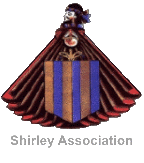

 |
 Shirley
Village Shirley
Village Derbyshire |
|
||
|
SHIRLEY VILLAGE Shirley is approximately four miles SSE of Ashbourne and lies one mile to the west of the A52 between Brailsford and Osmaston. An early settlement dating back at least to Saxon times, Shirley being, it is thought, taken from the Saxon word - Sirelea - meaning 'clear place or pasture'. At the time of the Domesday survey 1079-86 Henry de Ferrars was overlord of a Saxon Thane called Sewallis who was Lord of The Manors of Etwall, Hatton and Hoon in Derbyshire and the Manor of Eatington in Warwickshire, his main and ancient family seat. Sewallis family later took the name 'de Shirley'. Sewallis' son Fulcher was the first to hold Shirley. At this time Sirelea (Shirley) was a small Derbyshire hamlet described in The Domesday Survey as follows - 2 ploughs, 6 villagers and 7 smallholders with 3 ploughs, a Priest and a church, and l mill. The Shirley family played an important role as military men of some distinction. One of their ancestors Sewallis de Shirley accompanied William Earl Ferrars under King Richard 1st. on the third crusade to the Holy Land. Another, Sir Ralph Shirley was one of Henry V's commanders at the battle of Agincourt in 1415. In 1423 Sir Ralph's son also Ralph, married Margaret the sister and sole heir of Thomas Staunton. They inherited the manor of Staunton Harold in Leicestershire which became the chief seat of the Shirley's. By 1611 a descendant, Sir George, became a Baronet. Sir George's great-grandson was made Lord Ferrers and Viscount Tamworth in 1711. The Shirley family have given hundreds of years of service to Church and State, and still play a vital role in fund raising etc. for the church. Popular belief suggests that Bonnie Prince Charlie spent a night in Shirley as his army passed close by on their march to Derby during 1745, they got as far as Swarkestone, but as far as I am aware, no further.
Aerial Photos of Shirley Village
|
St. Michael's Church - Church Lane. There has been a Church on the present site since Saxon times, the present building dating from C14, with alterations carried out in 1842 and 1861. It consists of two aisles and a chancel. In the churchyard can be found the stump and the base of an old stone cross and a yew tree with a circumference of 17 feet, both are thought to date from the eleventh century. An old tree appears to have grown 'out of the wall' and is hollow with a large hole through it yet it still lives! The church has a fine old organ which has recently been restored. THE CHURCH The Church as it now exists consists of chancel, nave, north and south aisles, south porch and tower. The oldest part of the church may be the chancel arch, now much restored, having completely lost its Norman shape in the restoration of 1842. The Pews through out the Church date from 1842. It is said that there were many well carved oak pews in the Church before 1842. The only remnant of these is to be seen at the east end of the south aisle with the initials C.C. M.C. and the date 1649. Possibly this may have been the pew of the family of Colwich. This family was assigned the site of the dissolved perceptory at Yeaveley in 1559 (in Shirley Parish at that time). They held the land for over a century. The South Aisle and Chancel Standing at the back of the Church under the gallery, the next oldest part dates from the first half of the fourteenth century (1300-1350). this is the south aisle on the right, with its windows, the arcade of two bays supported by an octagonal pillar between the aisle and the nave. The chancel with its windows, priests door, buttresses and well moulded wall plate also are of the same date. The architecture is known as the Decorated style of Gothic or early English. Thousands of couples have exchanged their marriage vows in this church. Think how many babies have been baptised here over so many centuries. The registers begin in 1658. It is a tradition of the Earl Ferrers family (whose family name is Shirley and who still live in the Parish) that their children are baptised here. The North Aisle This was only added in 1842, and was built as an imitation
of the much older South Aisle. At the east end there is a large
monument to Bishop Shirley. he was both Bishop and Vicar of Shirley
for many years, and responsible for the restoration. He was elected
Bishop of Sodor and Man and Consecrated, but died in 1847 before
his enthronement. Another member of the Shirley family is remembered
in a mural brass cross erected |
|||
|
|
||||
|
All Rights Reserved |
||||